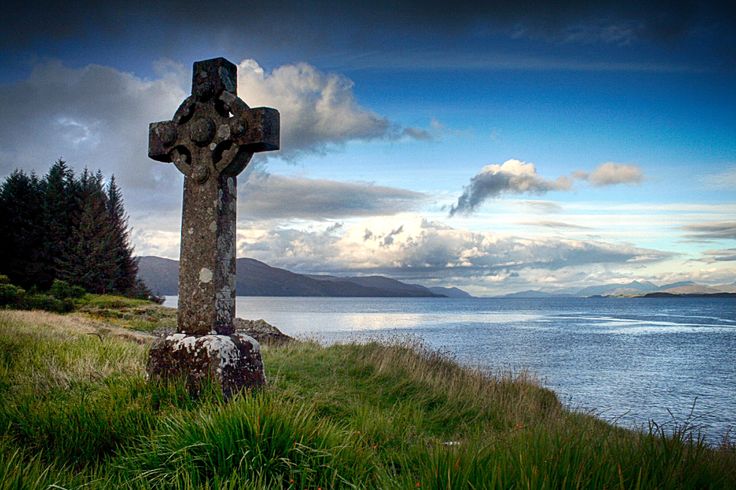I have always loved the symbol of the cross as it reminds me of Jesus’ deep love and sacrifice. I have many cross necklaces as well as art pieces that decorate my home and office. There are many styles of crosses, but my favorite is the Celtic cross. In his book Exploring Celtic Spirituality, Ray Simpson helps us understand the meaning behind this symbol:
“A cross breaking through a circle, carved on a pillar of stone, is the typical Celtic symbol. Pillars of stone were a universal symbol of the link between heaven and earth. The circle round the cross was introduced by the Emperor Constantine as a symbol of the wreath of victory. But only in Celtic lands did it remain fashionable, probably because the circle also came to represent the created world, which the Celts so highly valued. The Celtic cross speaks of victory, wholeness, the transforming power of Christ in all creation.
“The old pagan and today’s New Age philosophies offer us a circle without a cross. The Augustinian philosophy offered a cross without a circle. Our world stands in need of both the cross and the circle.”
This way of thinking about creation and the cross reflects the words of Scripture. At the end of each day of creation in Genesis 1, we read, “God saw that it was very good.” On the sixth day, “God saw everything that he had made, and indeed, it was very good.” The Celts understood the goodness of God’s creation. This included their understanding of people. Humans are marred by sin and unable, helpless even, to do anything about it. But the good image of God is still in all people. This is why everyone is worthy of love, dignity, and respect.
Paul wrote in Colossians 1:20, “God made peace through his son’s death on the cross and so brought back to himself all things, both on earth and in heaven.” In this passage and elsewhere, Paul makes clear that Christ’s saving work on the cross is not only about God reconciling individuals to himself but reconciling the whole of creation in heaven and on earth. The cross doesn’t merely reveal what God has done in Christ. It reveals who God is. As one writer said, “There is a cross in the heart of God before there was one planted outside Jerusalem, and now the cross of wood has been taken down, the one in the heart of God abides.”
For the Celts, the cross is the symbol of God’s defeating the power of evil in the world through the death of Christ. Like Paul, they believed that creation was yet to be reconciled and transformed into its fullness of divine glory.
In Romans 8:18-21, Paul writes, “I consider that the sufferings of this present time are not worth comparing with the glory about to be revealed to us. For the creation waits with eager longing for the revealing of the children of God, for the creation was subjected to futility, not of its own will, but by the will of the one who subjected it, in hope that the creation itself will be set free from its enslavement to decay and will obtain the freedom of the glory of the children of God.” The Celtic cross reminds us that through the death of Jesus, God has set his people free from the bondage of sin and will set the world free from enslavement to decay. This is why they put a high value on seeing themselves as stewards of God’s creation.
As I was reflecting this week on the cross and creation, I thought of the two primary ways that God reveals himself: natural and specific revelation. Natural, or general, revelation is truth about God that can be discerned by looking at the world around us. Romans 1:20 is a key verse for understanding general revelation: “Ever since the creation of the world God’s eternal power and divine nature, invisible though they are, have been seen and understood through the things God has made.” Everyone in every place has access to natural revelation so everyone can receive and understand some knowledge about God.
A week ago the choir sang a beautiful hymn based on Psalm 19:1–4, which refers to the abundance and accessibility of natural revelation: “The heavens declare the glory of God; the skies proclaim the work of his hands. Day after day they pour forth speech; night after night they reveal knowledge. They have no speech, they use no words; no sound is heard from them. Yet their voice goes out into all the earth, their words to the ends of the world.”
It is interesting to note how Jesus uses nature and the creation to teach about the principles of the kingdom of God. He encouraged his disciples to look at the lilies and the birds to learn not to worry. Instead, they are encouraged to seek first the kingdom. Immovable mountains, daily sunrises, rushing winds, as well as the wilderness and wastelands can reveal the nature of God as creator and give us insight about his kingdom. The key is a willingness to stop and pay attention to God’s creation.
Just as we look at a painting and see something about the artist, so we can look at creation and learn things about God. A great Celtic leader St. Columba said, “If you want to know God, first get to know his creation.” As Gerald Manley Hopkins said, “The world is charged with the grandeur of God.”
We are to have an awareness of God’s presence in every moment of life in all the places we are and all the things we see, hear, and experience. Elizabeth Barrett Browning shows us not only what it looks like but how to respond to God’s presence: “Earth’s crammed with heaven, And every common bush afire with God, But only he who sees takes off his shoes; The rest sit round and pluck blackberries.”
The second way God reveals himself is through special revelation—that which comes directly from God (is inspired by God) and is recorded in Scripture. The content of this revelation is truth that we could not know or truly understand unless God told us directly. We understand God’s plan of redemption because the Spirit inspired truth in the Old and New Testament. The Word of God points to Jesus and his death on the cross as God’s means of salvation for people.
The Celtic Cross holds together general and special revelation of God in creation and in Christ and his finished work for us on the cross. As was stated before, we need both the circle and the cross to ground our life in the kingdom of God right here and now. Together they reveal the beauty and majesty of our great God, the goodness of his creation, and the wondrous cross on which our Savior died that we might enjoy a relationship with him now and forever.


